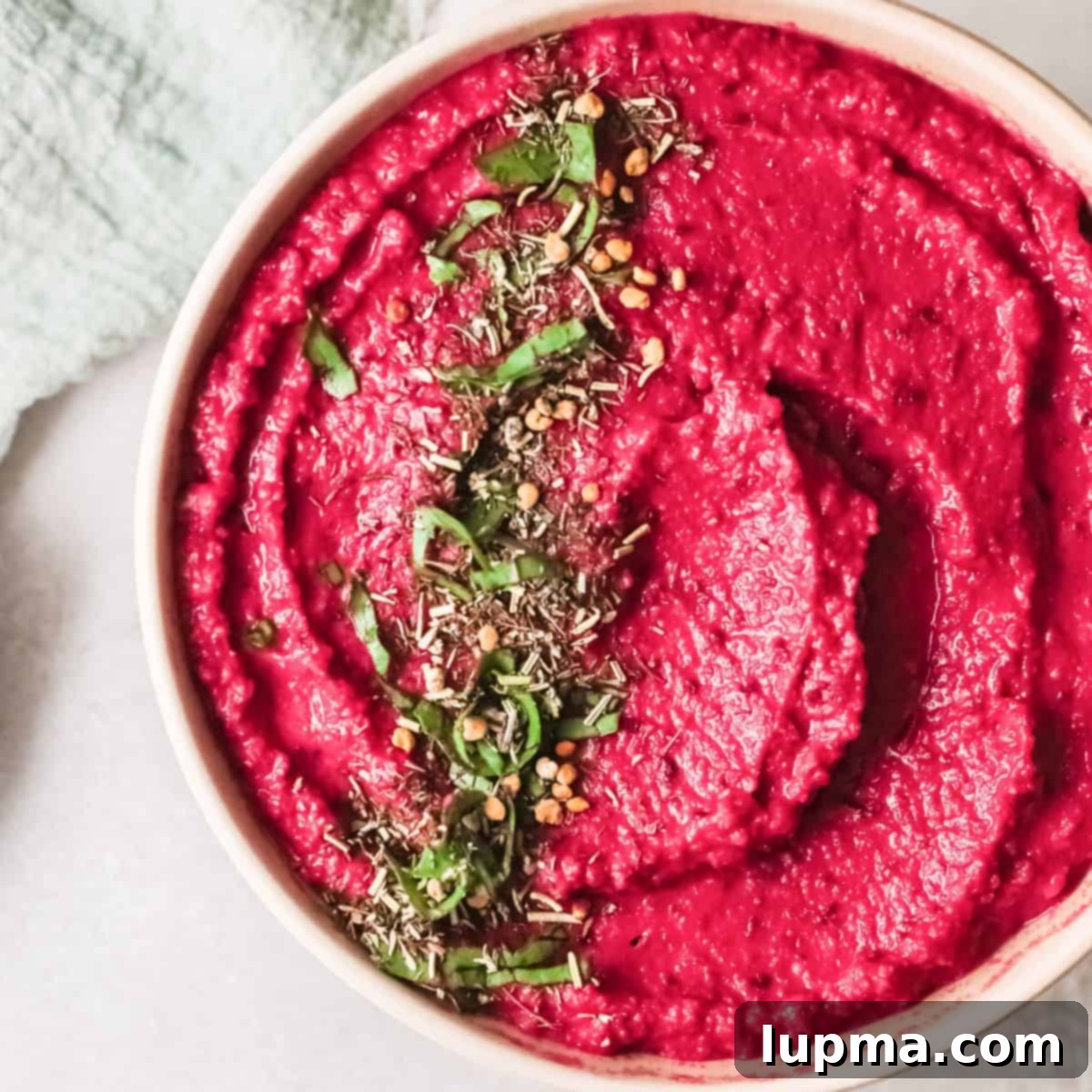Vibrant Roasted Beet Hummus: A Delicious & Healthy Mediterranean Dip
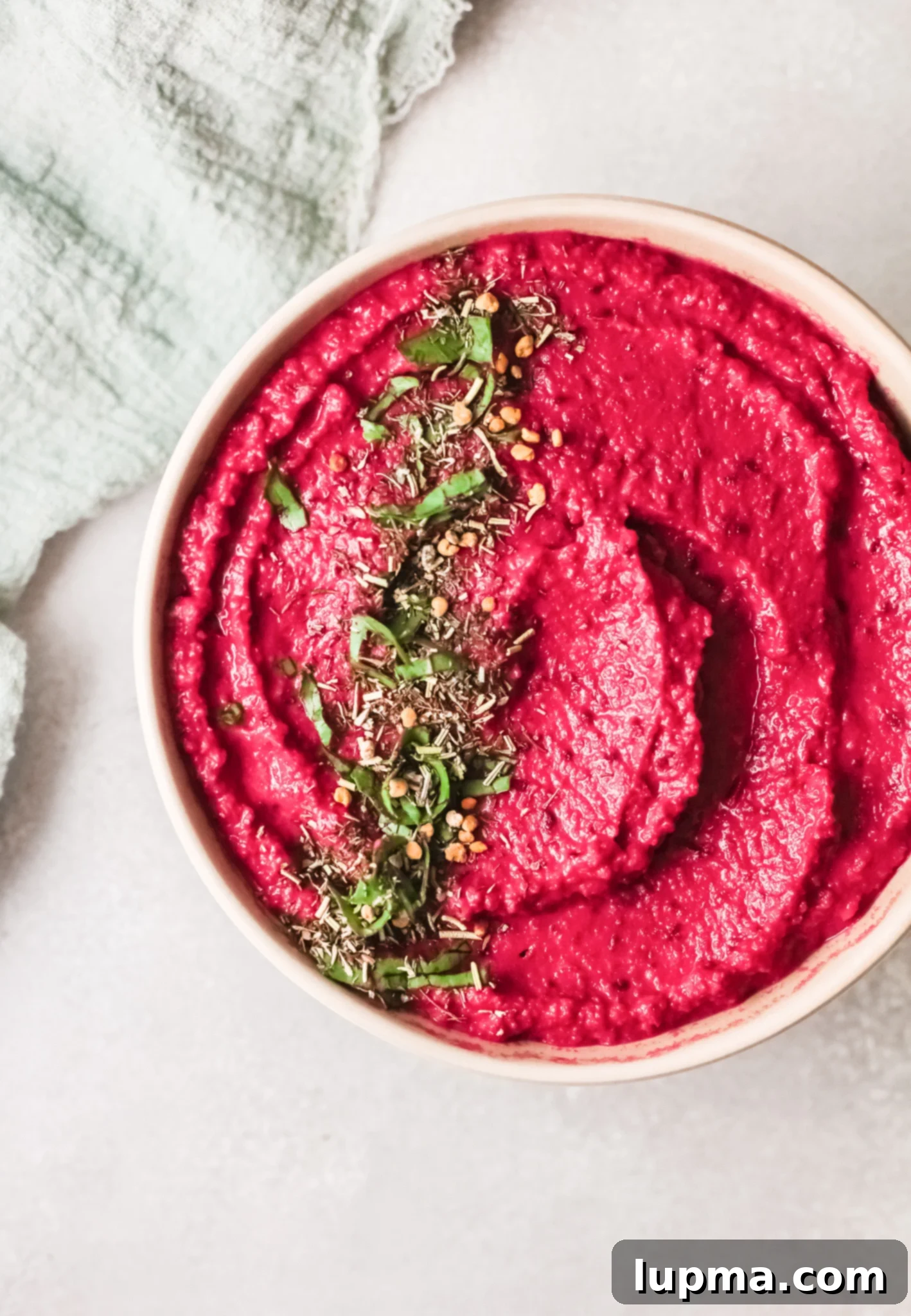
Welcome to a delightful culinary journey where the earthy sweetness of beets meets the creamy indulgence of traditional hummus. Our Vibrant Roasted Beet Hummus is more than just an appetizer; it’s a celebration of flavor, color, and wholesome ingredients. This recipe transforms a classic Mediterranean staple into a captivating dip that’s both visually stunning and incredibly nutritious. Made with tender roasted beets, protein-packed chickpeas, rich tahini, bright lemon juice, and pungent garlic, it offers a sophisticated twist on an everyday favorite.
This Mediterranean-inspired dip is exceptionally versatile. Serve it as a healthy appetizer with a platter of crisp fresh vegetables and warm pita bread, spread it generously on wraps and sandwiches for a flavorful lunch, or incorporate it into vibrant rice and grain bowls for a nourishing meal. Its naturally vibrant hue and complex flavor profile make it a showstopper at any gathering, while its simple preparation ensures it’s perfect for everyday enjoyment.
My connection to Mediterranean cuisine runs deep, stemming from my Lebanese heritage. Growing up, our family table was always adorned with an array of delicious and healthy dishes characteristic of the Mediterranean diet. These cherished recipes included classics like traditional hummus, savory stuffed grape leaves, fresh seafood such as Mediterranean Salmon, comforting Lebanese spinach pies, flavorful Lebanese green beans, and creamy baba ghanoush. Sharing these authentic and innovative recipes with you is a true passion of mine.
What makes this beet hummus truly special is the inclusion of roasted beets. Not only do they infuse the dip with an irresistible vibrant pink or purple color, but they also contribute a subtle, naturally sweet, and earthy flavor that beautifully complements the other ingredients. Roasting the beets caramelizes their natural sugars, intensifying their taste and adding a delightful depth that raw beets simply cannot achieve. This method ensures a richer, more nuanced hummus experience.
If you’re already a fan of hummus, you’ll love exploring its many delightful variations. Beyond this gorgeous beet version, be sure to try my bright Lemon Hummus, smoky Roasted Red Pepper Hummus, a beautifully arranged Hummus Platter for entertaining, or the hearty Ground Beef Layered Hummus for a more substantial meal. Each recipe offers a unique take on this beloved Middle Eastern spread, proving just how versatile chickpeas can be!
Why You’ll Love This Roasted Beet Hummus
Beyond its striking appearance, our Roasted Beet Hummus boasts a myriad of reasons why it should become a staple in your kitchen:
- Unforgettable Flavor: The roasting process brings out an incredible sweetness in the beets, which, when combined with the nutty tahini, zesty lemon, and savory garlic, creates a perfectly balanced and uniquely delicious taste. It’s an elevated flavor profile that will impress even the most discerning palates.
- Stunning Visual Appeal: The natural pigments in beets lend a gorgeous pink or deep magenta hue to the hummus, making it an instant showstopper. It’s perfect for adding a pop of color to any appetizer spread or meal.
- Incredibly Healthy: Beets are packed with essential vitamins and minerals, including folate, manganese, and Vitamin C, and are known for their antioxidant and anti-inflammatory properties. Chickpeas contribute significant fiber and plant-based protein, making this a truly nourishing dip that supports a healthy lifestyle.
- Dietary Friendly: This recipe is naturally vegan, vegetarian, and gluten-free, catering to a wide range of dietary needs and preferences without compromising on taste or texture.
- Versatile Use: Whether you’re looking for a simple snack, an elegant appetizer, or a flavorful condiment, this beet hummus fits the bill. Its creamy texture and robust flavor make it adaptable to countless dishes.
- Easy to Make: Despite its gourmet appearance, this beet hummus is surprisingly simple to prepare, requiring only a few basic steps and a food processor or blender.
Essential Recipe Ingredients
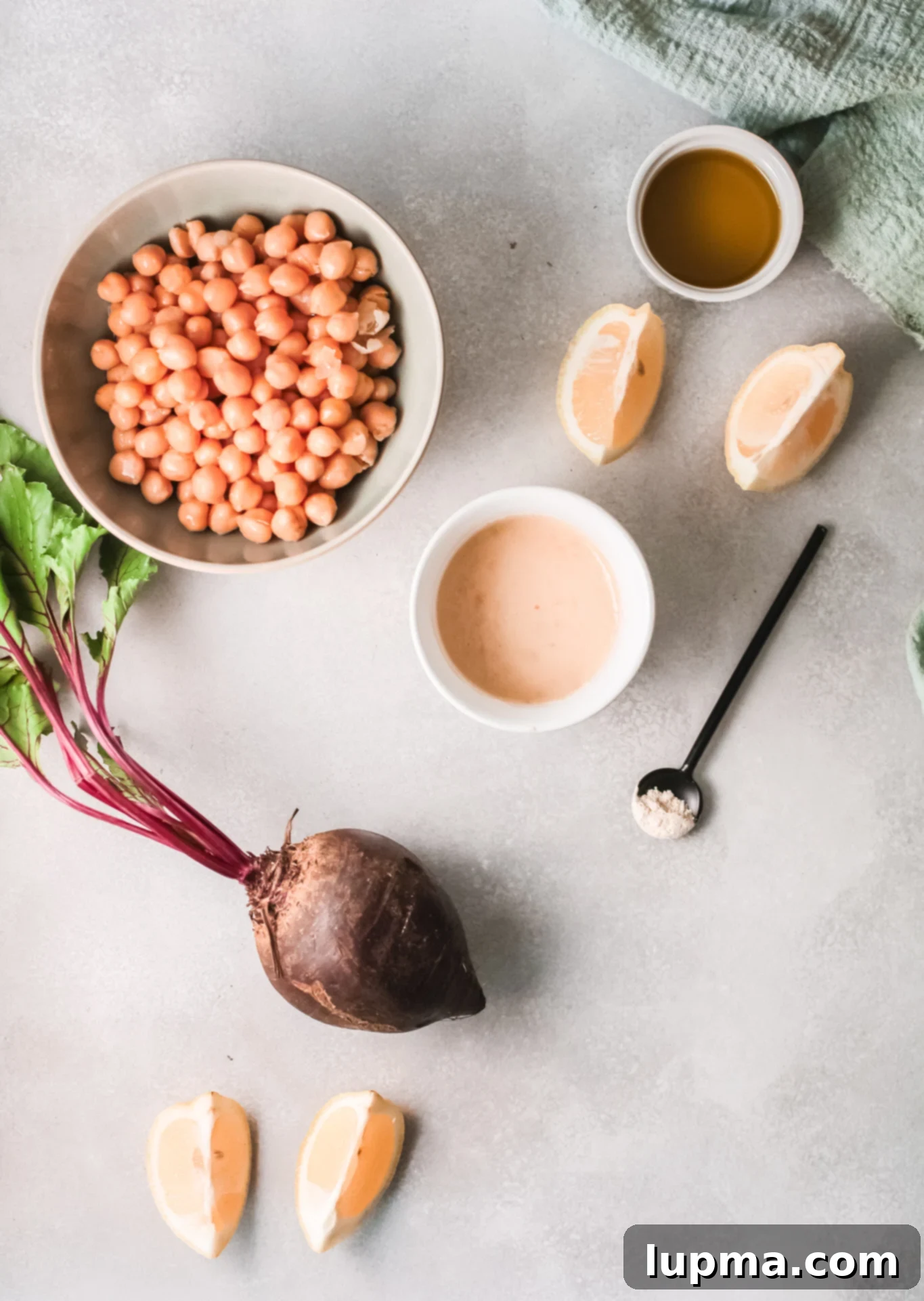
Crafting the perfect beet hummus begins with selecting high-quality, fresh ingredients. Below is an overview of the simple components we’ll be using. For precise measurements and step-by-step printable instructions, please refer to the recipe card at the bottom of this page.
- Beets: The undisputed star of this colorful hummus is the humble beet. While you can use any variety, red beets provide that stunning, signature vibrant color. Roasting the beets is key, as this process coaxes out their natural sugars, leading to a wonderful sweetness and a more complex, earthy flavor. This light yet impactful sweetness and bright hue truly elevate the entire hummus recipe.
- Chickpeas (Garbanzo Beans): As the foundation of any great hummus, chickpeas provide the creamy base and a healthy dose of plant-based protein and fiber. I typically use a 15-ounce can of chickpeas, ensuring they are thoroughly drained and rinsed before use. Sometimes, I like to set aside a small handful of whole chickpeas to sprinkle on top of the finished hummus as a textural garnish.
- Tahini: Also known as sesame paste, tahini is an essential ingredient in authentic hummus, imparting a distinctive nutty, slightly bitter flavor and contributing to the dip’s signature smooth, velvety texture. Made from ground sesame seeds, it’s crucial to give the tahini a good stir before measuring, as the natural oils often separate and rise to the top of the jar.
- Lemon Juice: Freshly squeezed lemon juice is paramount for balancing the richness of the tahini and the sweetness of the beets. It adds a crucial bright, tangy, and zesty note that elevates all the flavors in this Roasted Beet Hummus.
- Garlic: A few cloves of fresh garlic are vital for that classic pungent, savory depth found in traditional hummus. You can adjust the quantity based on your preference for a milder or more assertive garlic flavor.
- Extra Virgin Olive Oil: Used both for roasting the beets and for achieving that coveted silky smooth hummus texture. A good quality extra virgin olive oil also adds a rich, fruity flavor and healthy monounsaturated fats.
- Seasonings: Simple salt and freshly ground black pepper are used to enhance the flavors of the beets during roasting and to season the final hummus to perfection. Garlic powder and onion powder are also added to the beets for an extra layer of savory depth during the roasting process.
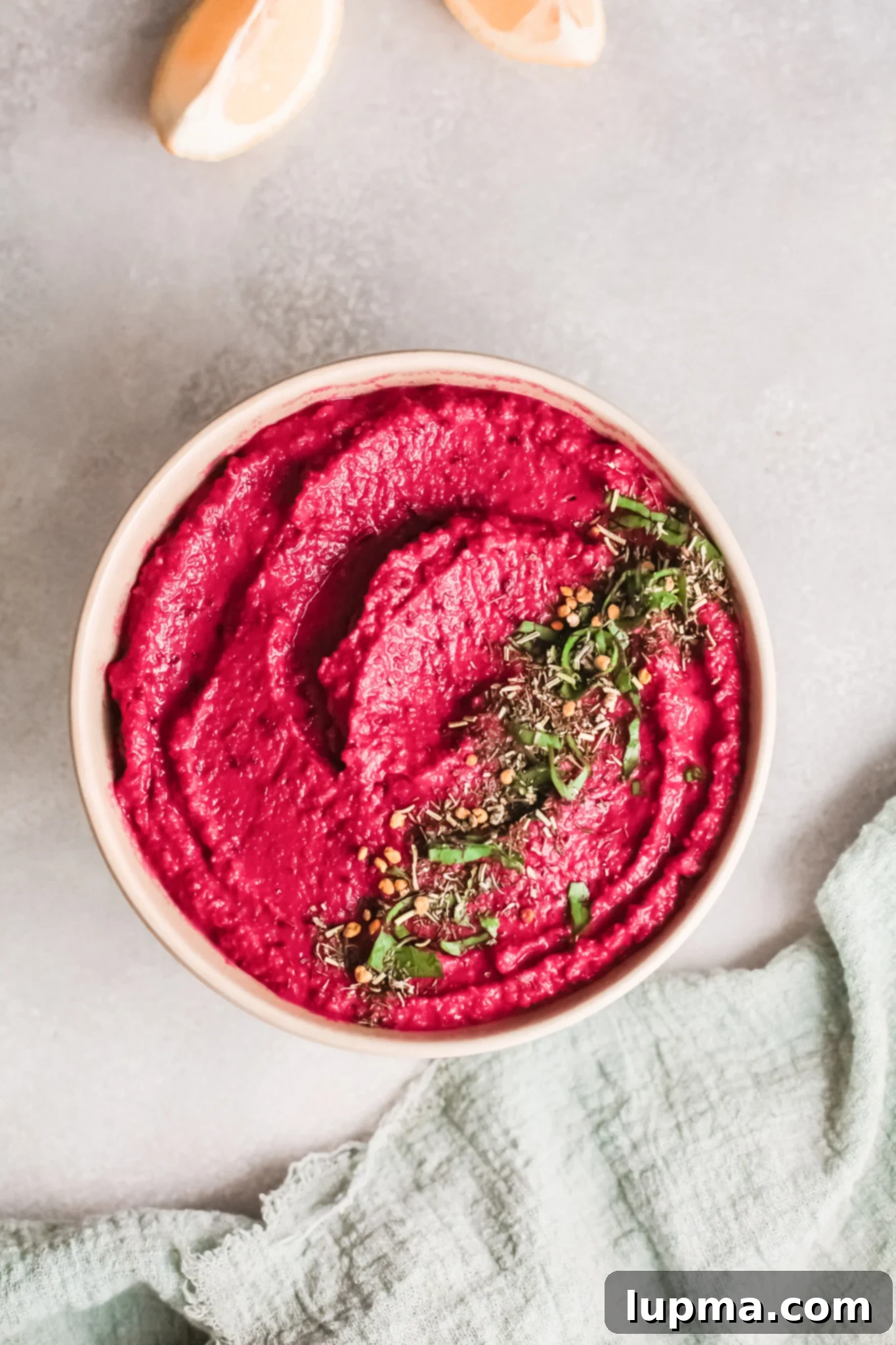
Elevate Your Hummus with Delicious Toppings
While our Vibrant Roasted Beet Hummus is utterly delicious on its own, adding toppings can transform it into an even more exciting and visually appealing dish. Here are some fantastic ideas to elevate your hummus experience, adding contrasting textures, fresh flavors, and vibrant colors:
- Fresh Herbs: A generous sprinkle of freshly chopped herbs is an effortless way to introduce brightness, color, and aromatic notes. Popular choices include parsley for a fresh, clean taste; cilantro for a more pungent, citrusy flavor; dill for a unique herbaceousness; mint for a cooling sensation; or a mix of thyme and oregano for classic Mediterranean flair.
- Seeds & Nuts: For a delightful textural contrast against the smooth hummus, consider adding crunchy elements. Toasted pine nuts are a classic choice, offering a buttery richness. Other excellent options include sunflower seeds, slivered almonds, chopped walnuts, or even pistachios, which provide both crunch and a lovely nutty depth. Lightly toasting them in a dry pan enhances their flavor significantly.
- Citrus Zest: A finely grated sprinkle of lemon zest, or even orange zest, adds an intense burst of fresh citrus aroma and flavor right before serving. This brightens the dish beautifully and reinforces the existing lemon notes in the hummus.
- Whole Chickpeas: As mentioned, reserving a few whole chickpeas before blending and sprinkling them on top offers an appealing visual cue and a pleasing textural pop. It’s a simple yet effective garnish.
- Cheese: For those who aren’t strictly vegan, crumbled feta cheese is a fantastic addition. Its salty, tangy, and slightly creamy nature provides a wonderful contrast to the sweet and earthy hummus. A sprinkle of crumbled goat cheese can also offer a similar delightful tang.
- Fresh Vegetables: Diced fresh vegetables not only add color but also a refreshing crunch. Think finely diced cucumbers, cherry tomatoes, bell peppers (red or yellow), or even thinly sliced radishes. These are particularly great on recipes like my Lebanese-Style Hummus, but work wonderfully here too.
- A Drizzle of Quality Olive Oil: A final swirl of extra virgin olive oil over the top of the hummus is a must. It adds richness, a beautiful sheen, and enhances the overall Mediterranean flavor.
- Spices: A light dusting of paprika (sweet or smoked), sumac (for a tangy, lemony note), or even a pinch of Aleppo pepper can add an extra layer of flavor and visual appeal.
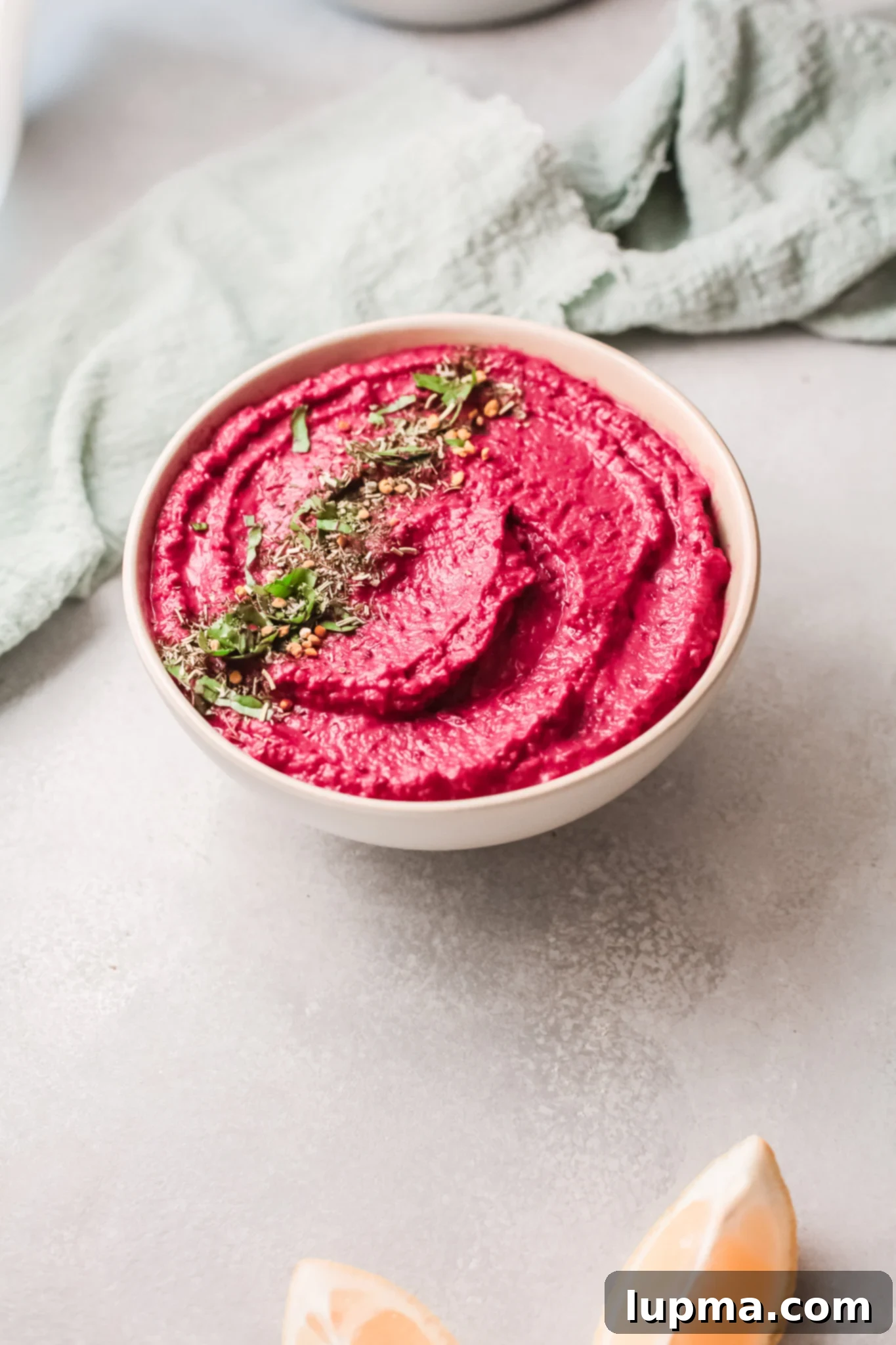
How to Perfectly Roast Beets for Hummus
The secret to this incredibly flavorful beet hummus lies in the roasting process. Roasting beets not only softens them to a silky texture ideal for blending but also caramelizes their natural sugars, intensifying their sweetness and depth of flavor. Follow these simple steps for perfectly roasted beets:
- Step 1: Prepare the Beets: Start by preheating your oven to 350 degrees Fahrenheit (175 degrees Celsius). While the oven heats, wash your small beet thoroughly. You can peel the beet before roasting, or roast it with the skin on and peel it once it’s cooled (the skin will slip off easily). Dice the peeled beet into roughly 1-inch cubes. Place the diced beet into a mixing bowl. Drizzle with a tablespoon or two of olive oil, then season with garlic powder, onion powder, salt, and freshly ground black pepper. Toss everything together until the beet pieces are evenly coated.
- Step 2: Roast Beets to Perfection: Arrange the seasoned beet pieces in a single, even layer on an oven-safe skillet, a baking dish, or a baking sheet lined with parchment paper. Spreading them out ensures they roast rather than steam, leading to better caramelization. Place the beets in the preheated oven and roast for approximately 35-45 minutes, or until they are fork-tender and slightly caramelized. The exact time will depend on the size of your beet pieces.
- Step 3: Cool Completely: Once roasted, remove the beets from the oven and allow them to cool down completely to room temperature. This step is crucial before adding them to the food processor with the other hummus ingredients, as hot beets can affect the texture and potentially warm up the hummus too much.
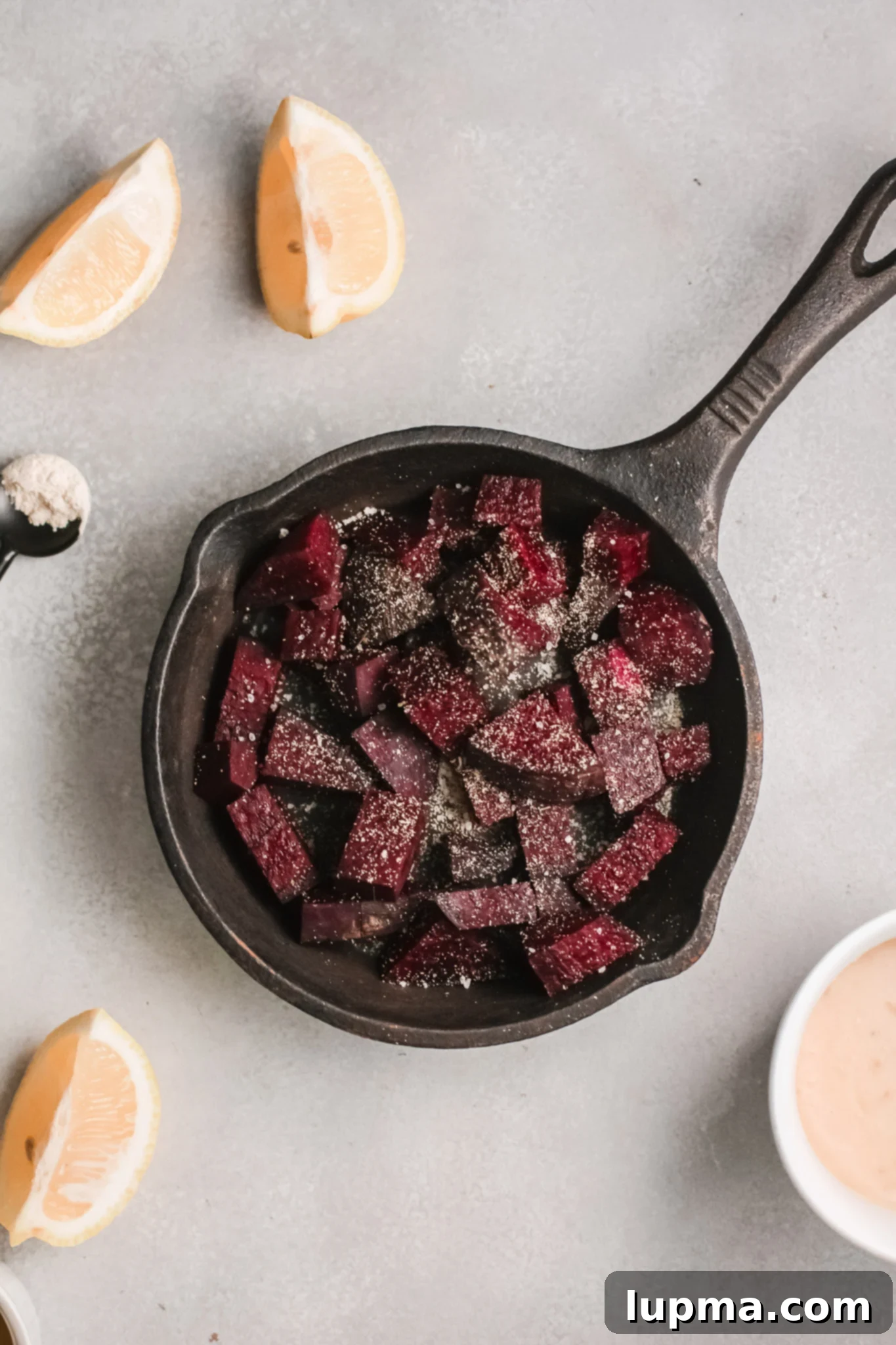
Creating Your Perfect Beet Hummus
With your beets perfectly roasted and cooled, you’re just a few simple steps away from enjoying this delicious and vibrant hummus. The process is quick and easy, primarily involving your food processor or high-speed blender.
- Step 1: Initial Blending of Beets: Transfer the cooled roasted beet to your food processor or blender. Pulse a few times to break down the larger pieces and start forming a coarse paste. This helps ensure the beets are fully incorporated into the hummus without leaving large chunks.
- Step 2: Combine Hummus Ingredients: Add the drained and rinsed chickpeas, tahini, minced garlic cloves, and fresh lemon juice to the food processor or blender with the beets. Process these ingredients continuously until the mixture becomes relatively smooth, which typically takes around 2-3 minutes. You may need to stop and scrape down the sides of the bowl a few times to ensure everything is evenly blended.
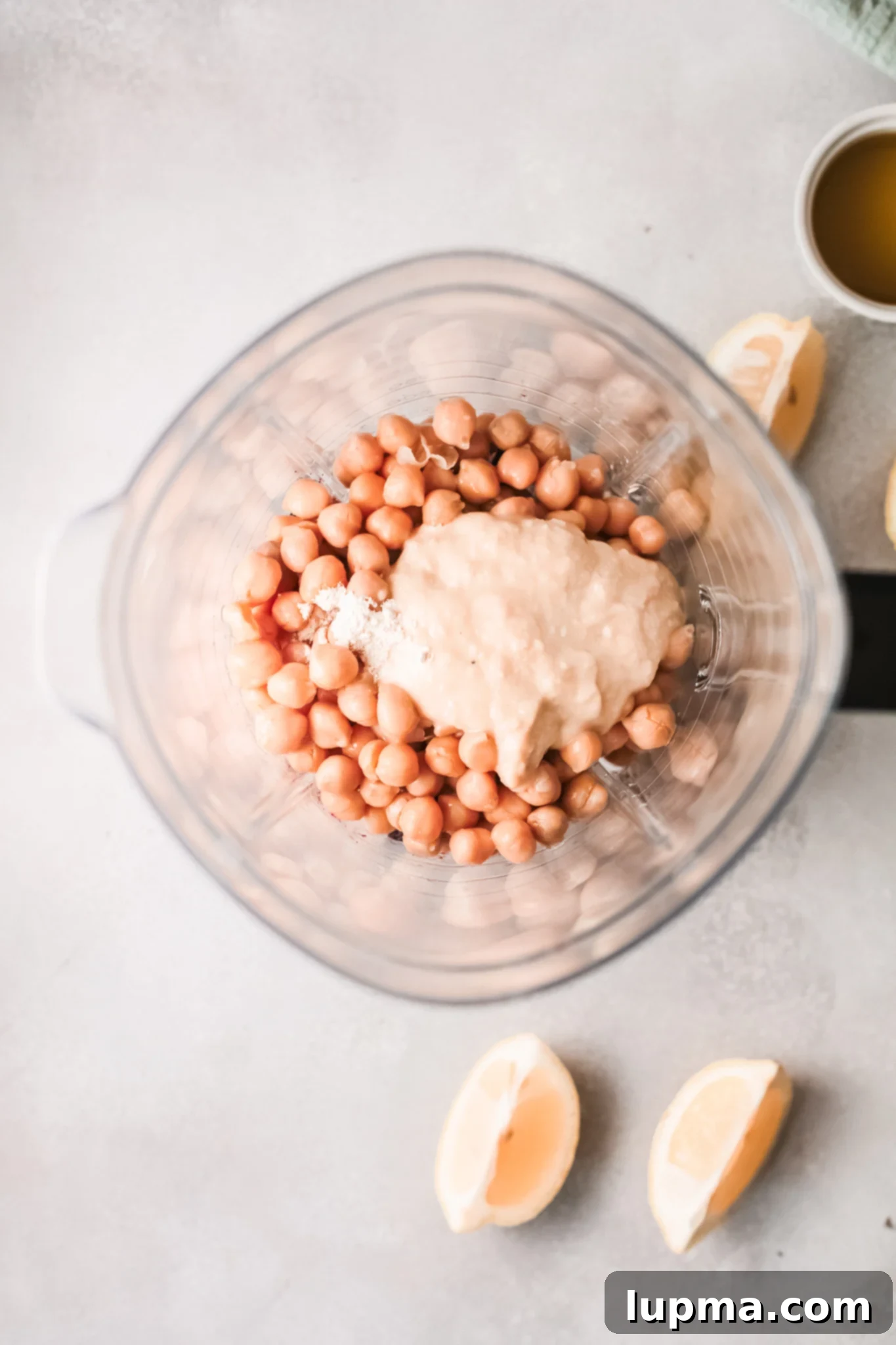
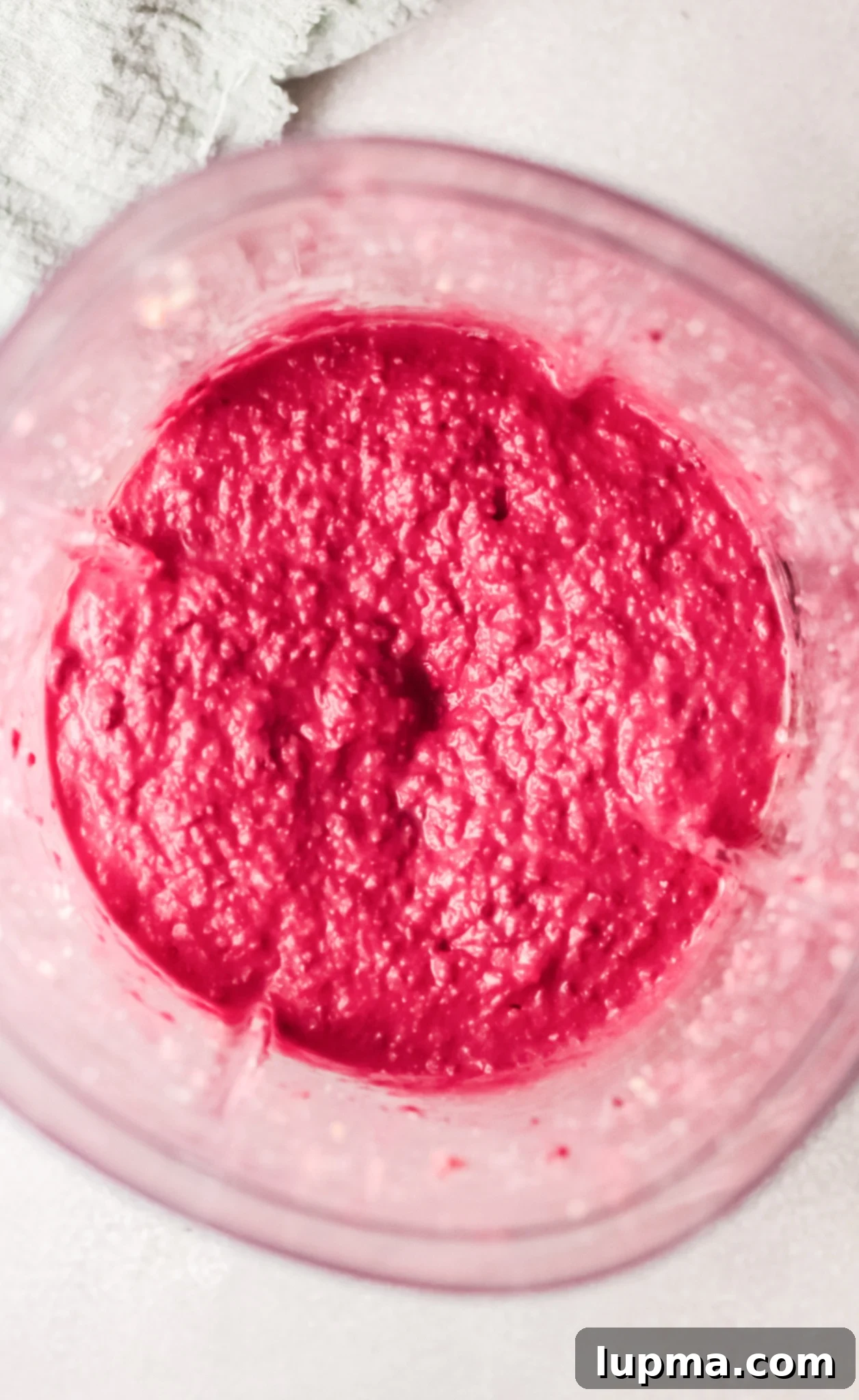
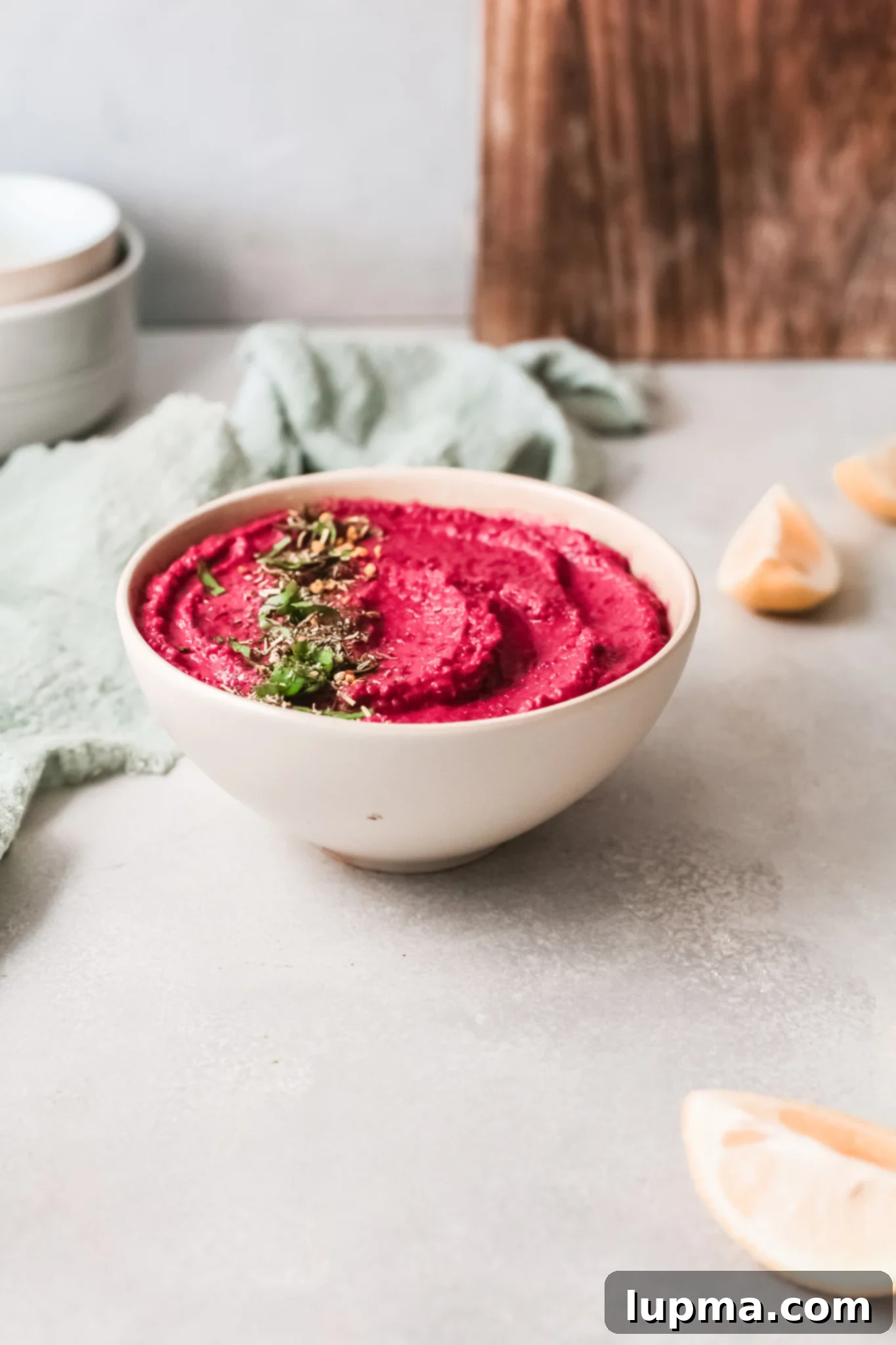
Storage & Make-Ahead Tips
This Roasted Beet Hummus is an excellent make-ahead dish, perfect for meal prepping or preparing for entertaining. Its flavors tend to meld and deepen beautifully over time.
- Refrigeration: Store any leftover hummus in an airtight container in the refrigerator for up to 4 days. To maintain its vibrant color and freshness, you might want to place a piece of plastic wrap directly on the surface of the hummus before sealing the container to prevent a skin from forming.
- Serving Leftovers: Before serving leftover hummus, give it a good stir. If it has thickened slightly in the fridge, you can easily restore its creamy consistency by stirring in a little extra virgin olive oil, a splash of cold water, or a tiny bit more lemon juice until it reaches your desired texture.
- Freezing (Optional): While hummus can be frozen, the texture may change slightly upon thawing. It might become a bit grainier. If you choose to freeze it, place it in an airtight, freezer-safe container, leaving about an inch of headspace. It can be frozen for up to 2-3 months. Thaw overnight in the refrigerator, then stir vigorously, adding a little olive oil or water to re-emulsify and smooth out the texture before serving.
The Healthy Advantages of Beet Hummus
Beyond its incredible taste and stunning color, this Vibrant Roasted Beet Hummus is a powerhouse of nutrition, aligning perfectly with the principles of the healthy Mediterranean diet:
- Rich in Antioxidants: Beets are loaded with powerful antioxidants, particularly betalains, which give them their distinctive color. These compounds help combat oxidative stress and inflammation in the body.
- High in Fiber: Both beets and chickpeas are excellent sources of dietary fiber. Fiber is crucial for digestive health, helps regulate blood sugar levels, and contributes to a feeling of fullness, aiding in weight management.
- Plant-Based Protein: Chickpeas provide a substantial amount of plant-based protein, making this hummus a great option for vegetarians, vegans, and anyone looking to increase their protein intake. Protein is essential for muscle repair, growth, and overall bodily functions.
- Packed with Vitamins and Minerals: Beets contribute vital nutrients such as folate (important for cell function and tissue growth), manganese (key for bone health and metabolism), and Vitamin C (an immune booster). Chickpeas add iron, zinc, and B vitamins.
- Heart-Healthy Fats: The extra virgin olive oil and tahini contribute healthy monounsaturated and polyunsaturated fats, which are beneficial for heart health and help with nutrient absorption.
- Naturally Low in Cholesterol: Being entirely plant-based, this hummus is naturally cholesterol-free, making it a heart-healthy snack or meal component.
Incorporating this delicious beet hummus into your diet is a flavorful way to boost your intake of wholesome ingredients and enjoy a truly nourishing dip!
Discover More Hummus Recipes
Loved this beet hummus? Explore other exciting variations that bring unique flavors and textures to this timeless dip:
Mediterranean
Buffalo Chicken Hummus Bites
Beef
Hummus with Spiced Beef and Toasted Pine Nuts
Vegetarian
Mediterranean Hummus Toast with Za’atar
Appetizers
Cucumber Hummus Bites
Tried this recipe? Leave a star rating and comment below! Subscribe to my newsletter or follow me on
Facebook,
Instagram, or
Pinterest for the latest.
Easy Beet Hummus
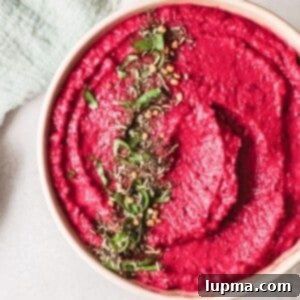
Pin
Ingredients
- 1 small Beet, peeled and diced
- Salt and pepper
- 2 tablespoons of olive oil
- 1 teaspoon garlic powder
- 1 teaspoon onion powder
- 1/2 teaspoon salt
- 1/8 teaspoon pepper
For the hummus:
- 1 seasoned roasted beet
- 1 can of chickpeas, drained and rinsed
- 2 tablespoons tahini
- juice of 1 lemon
- 1 to 2 garlic cloves
- 1/4 cup extra virgin olive oil
- 1/4 teaspoon salt
- 1/8 teaspoon pepper
- Garnish with fresh herbs like parsley, thyme or oregano
Instructions
For the roasted beet:
-
Preheat the oven to 350 degrees. Place the beet, olive oil, garlic and onion powder and salt and pepper in a mixing bowl. Toss to coat.
-
In an oven safe skillet, baking dish or baking sheet spread the beets in an even layer.
-
Put the beets in the oven and roast for 35 minutes or until soft.
-
Remove from the oven and let it cool down completely.
To prepare the hummus:
-
Put the roasted beet in the food procesor or blender and pulese a few times.
-
Add the chickpeas, tahini, garlic and lemon juice to a blender or food processor and pulse until smooth, around 2-3 minutes.
-
With the blender or food processor running slowly pour in the olive oil and continue blending until silky. Add salt and pepper to taste and blend once more. Taste and adjust the lemon juice, salt and pepper to your tastes. Place in a serving bowl and garnish with fresh herbs, feta cheese, chickpeas or chopped beets
Notes
- If the hummus is too thick for your liking you can add more olive oil slowly while the food processor is running until you reach the consistency you like. You can also add a tablespoon of cold water or a few ice cubes for a lighter texture.
- Optional garnish ideas: Chopped cilantro, sesame seeds, bee pollen, mint, sunflower seeds, olive oil, crumbled feta cheese, lemon zest, fresh chickpeas, chopped cooked beets, a sprinkle of paprika or sumac.
Nutrition
Nutrition information is automatically calculated, so should only be used as an approximation.
